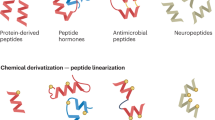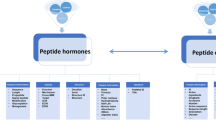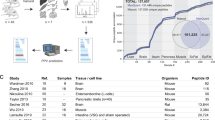Abstract
Naturally occurring peptides with biological actions have in most cases been detected by observing their biological activities in crude extracts and their isolation has been followed using bioassays. As a complement to the classical biological detection systems, we have proposed a chemical detection system based on fragmentation of peptides in tissue extracts followed by identification of certain of these peptide fragments having distinct chemical features1,2. One such chemical feature is the C-terminal amide structure which is characteristic of many biologically active peptides3,4. We have devised a chemical assay method for peptides having such a structure and have found several previously unknown peptide amides in porcine upper small intestinal tissues1. We report here the isolation and characterization of two of them, designated PHI and PYY. PHI is related to secretin, vasoactive intestinal poly peptide (VIP, glucagon and gastric inhibitory polypeptide (GIP); PYY is related to the pancreatic polypeptide and to neurotensin. Both peptides exhibit biological activities and appear to be present not only in the intestine but also in brain.
This is a preview of subscription content, access via your institution
Access options
Subscribe to this journal
Receive 51 print issues and online access
$199.00 per year
only $3.90 per issue
Buy this article
- Purchase on Springer Link
- Instant access to full article PDF
Prices may be subject to local taxes which are calculated during checkout
Similar content being viewed by others
References
Tatemoto, K. & Mutt, V. Proc. natn. Acad. Sci. U.S.A. 75, 4115–4119 (1978).
Tatemoto, K. & Mutt, V. Scand. J. Gastroenterol 13, Suppl. 49, 181 (1978).
Dayhoff, M. O. in Atlas of Protein Sequence and Structure Vol. 5 (ed. Dayhoff, M. O.) D173–D227 (National Biochemical Research Foundation, Silver Spring, Maryland, 1972).
Hunt, L. T. & Dayhoff, M. O. in Atlas of Protein Sequence and Structure Vol. 5, Suppl. II (ed. Dayhoff, M. O.) 113–145 (National Biochemical Research Foundation, Silver Spring, Maryland, 1976).
Mutt, V. in Gut Hormones (ed. Bloom, S. R.) 21–27 (Churchill-Livingstone, Edinburgh, 1978).
Bataille, D. et al. Scand. J. Gastroenterol. 13, Suppl. 49, 13 (1978).
Szecówka, J., Tatemoto, K., Mutt, V. & Efendić, S. Life Sci. 26, 435–438 (1980).
Li, T-M. & Chance, R. E. Gastroenterology 67, 737–738 (1974).
Chance, R. E., Johnson, M. G., Hoffman, J. A. & Lin, T-M. in Proinsulin, Insulin, C-peptide (eds Baba, S., Kaneko, T. & Yanaihara, N.) 419–425 (Excerpta Medica, Amsterdam, 1979).
Carraway, R. & Leeman, S. E. J. biol. Chem. 250, 1907–1911 (1975).
Author information
Authors and Affiliations
Rights and permissions
About this article
Cite this article
Tatemoto, K., Mutt, V. Isolation of two novel candidate hormones using a chemical method for finding naturally occurring polypeptides. Nature 285, 417–418 (1980). https://doi.org/10.1038/285417a0
Received:
Accepted:
Issue Date:
DOI: https://doi.org/10.1038/285417a0
This article is cited by
-
The Implication of Gut Hormones in the Regulation of Energy Homeostasis and Their Role in the Pathophysiology of Obesity
Current Obesity Reports (2020)
-
Chimeric peptide EP45 as a dual agonist at GLP-1 and NPY2R receptors
Scientific Reports (2018)
-
Peptide Tyrosine Tyrosine 3-36 Reduces Meal Size and Activates the Enteric Neurons in Male Sprague–Dawley Rats
Digestive Diseases and Sciences (2017)
-
Ventricular fibrillation resulting from electrolyte imbalance reveals vipoma in MEN1 syndrome
Familial Cancer (2016)
Comments
By submitting a comment you agree to abide by our Terms and Community Guidelines. If you find something abusive or that does not comply with our terms or guidelines please flag it as inappropriate.



